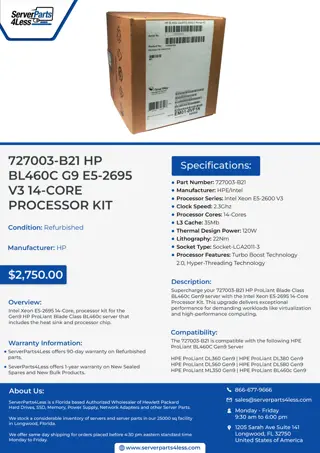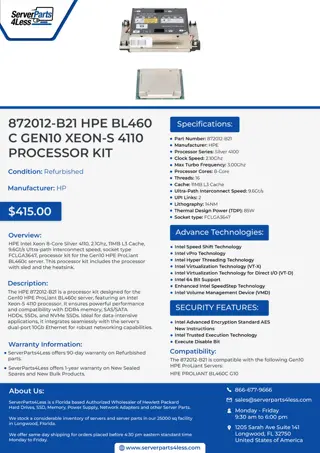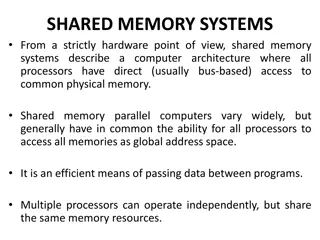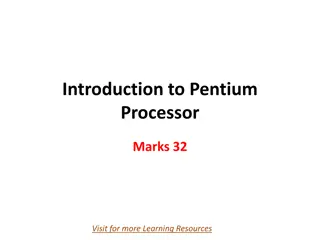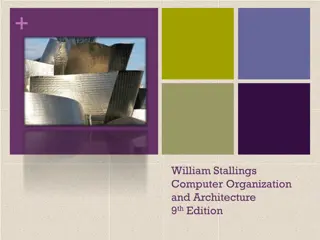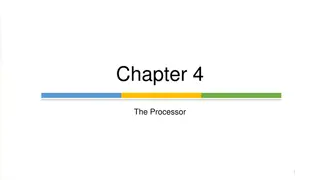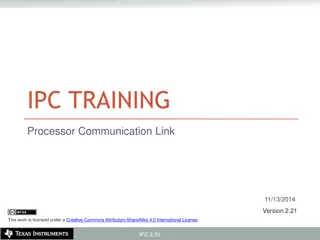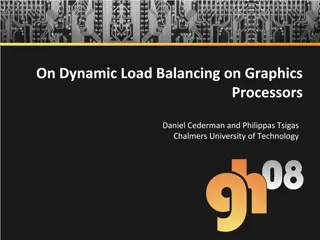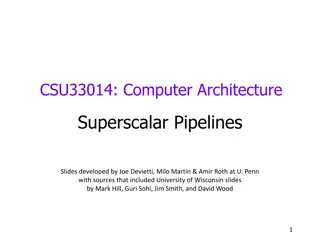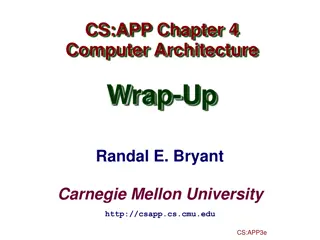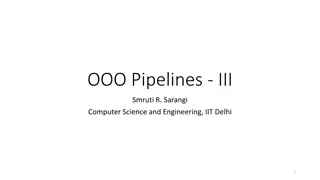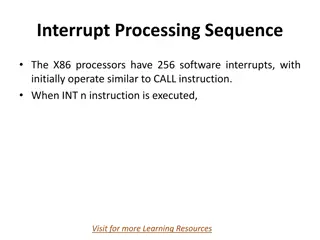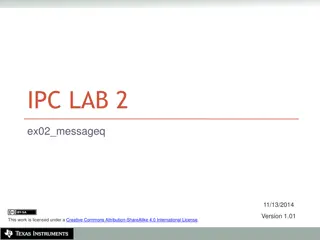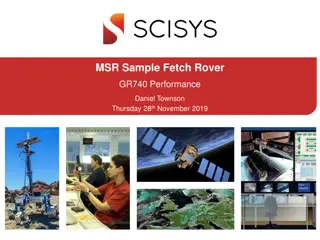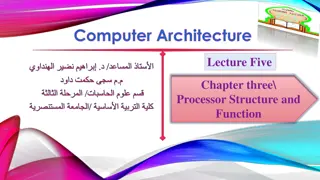Understanding Superscalar Processors in Processor Design
Explore the concept of superscalar processors in processor design, including the ability to execute instructions independently and concurrently. Learn about the difference between superscalar and superpipelined approaches, instruction-level parallelism, and the limitations and design issues involved. Gain insights into how superscalar processors improve the performance of executing scalar instructions and achieve parallelism through different pipelines.
- Superscalar Processors
- Instruction-Level Parallelism
- Processor Design
- Parallel Execution
- Pipelined Functional Unit
Download Presentation

Please find below an Image/Link to download the presentation.
The content on the website is provided AS IS for your information and personal use only. It may not be sold, licensed, or shared on other websites without obtaining consent from the author. Download presentation by click this link. If you encounter any issues during the download, it is possible that the publisher has removed the file from their server.
E N D
Presentation Transcript
Eastern Mediterranean University School of Computing and Technology Master of Technology Chapter 16 Chapter 16 Instruction Instruction- -Level Parallelism and Superscalar Processors Level Parallelism and Superscalar Processors
After studying this chapter, you should be able to: Explain the difference between superscalar and superpipelined approaches. Define instruction-level parallelism. Discuss dependencies and resource conflicts as limitations to instruction-level parallelism Present an overview of the design issues involved in instruction-level parallelism. 2
1. 1. Introduction Introduction A superscalar implementation of a processor architecture is one in which common instructions (integer and floating-point arithmetic, loads, stores, and conditional branches) can be initiated simultaneously and executed independently The superscalar approach can be used on either a RISC or CISC architecture. It is more appropriate to use in RISC architecture. 3
What is the essential characteristic of the superscalar approach to processor design 4
A superscalar processor typically fetches multiple instructions at a time and then attempts to find nearby instructions that are independent of one another and can therefore be executed in parallel executed in parallel. Once such dependencies have been identified, the processor may issue and complete instructions in an order that differs from that of the original machine code. 5
Superscalar Superscalar The term superscalar, first coined in 1987, refers to a machine that is designed to improve the performance of the execution of scalar instructions. In most applications, the bulk of the operations are on scalar quantities. The essence of the superscalar approach is the ability to execute instructions independently and concurrently in different pipelines. The concept can be further exploited by allowing instructions to be executed in an order different from the program order. 6
In a traditional scalar organization, there is a single pipelined functional unit for integer operations and one for floating-point operations. Parallelism is achieved by enabling multiple instructions to be at different stages of the pipeline at one time. 7
In the superscalar organization, there are multiple functional units, each of which is implemented as a pipeline. It is the responsibility of the hardware, in conjunction with the compiler, to assure that the parallel execution does not violate the intent of the program 8
An alternative approach to achieving greater performance is referred to as superpipelining, a term first coined in 1988. What is the difference between the superscalar and superpipelined approaches? Superpipelining exploits the fact that many pipeline stages perform tasks that require less than half a clock cycle. Thus, a doubled internal clock speed allows the performance of two tasks in one external clock cycle. one example of this approach with the MIPS R4000. 9
Comparison of Superscalar and Superpipeline Approaches Comparison of Superscalar and Superpipeline Approaches 10
The upper part of the diagram issues one instruction per clock cycle and can perform one pipeline stage per clock cycle. The execution stage is crosshatched for clarity. Note that although several instructions are executing concurrently, only one instruction is in its execution stage at any one time. 11
The next part of the diagram shows a superpipelined implementation that is capable of performing two pipeline stages per clock cycle. A superpipeline implementation that behaves in this fashion is said to be of degree 2 An alternative way of looking at this is that the functions performed in each stage can be split into two half a clock cycle. two non non- -overlapping overlapping parts parts and each can execute in 12
Finally, the lowest part of the diagram shows a superscalar implementation capable of executing two instances of each stage in parallel. Higher-degree superpipeline and superscalar implementations are of course possible. 13
Constraints Constraints The superscalar approach depends on the ability to execute multiple instructions in parallel. What is instruction-level parallelism? Instruction level parallelism refers to the degree to which the instructions of a program can be executed in parallel. A combination of compiler based optimization and hardware techniques can be used to maximize instruction level parallelism. 14
Before examining the design techniques used in superscalar machines to increase instruction-level parallelism, we need to look at the fundamental limitations to parallelism with which the system must cope. Researcher lists five limitations Limitations are: True data dependency Procedural dependency Resource conflicts Output dependency Antidependency 15
True Data Dependency [RAW] Consider the following instructions sequence: I : R2 <- R1 + R3 J : R4 <- R2 + R3 The second instruction J can be fetched and decoded but cannot execute until instruction second instruction needs data produced by the first instruction. This situation is referred to as a true data dependency after write [RAW] dependency). until the the first first instruction I I executes executes. The reason is that the true data dependency (also called flow dependency or read 16
Procedural Dependency The presence of branches in an instruction sequence complicates the pipeline operation. The instructions following a branch (taken or not taken) have a procedural dependency on the branch and cannot be executed until the branch is executed. procedural dependency scalar pipeline. This type of procedural dependency also affects a 17
Can not execute instructions after a branch until the branch is executed. (effect of a branch on a superscalar pipeline of degree 2, I1 is a branch) 18
Resource Conflict A resource conflict instructions for the same resource at the same time. resource conflict is a competition of two or more Examples of resources include memories, caches, buses, register-file ports, and functional units (e.g. ALU adder). 19
In terms of the pipeline, a resource conflict exhibits similar behavior to a data dependency. However, resource conflicts can be overcome by duplication of resources, whereas a true data dependency cannot be eliminated. 20
Output dependency: (Write after Write WAW) Two instructions update the same register, so the later instruction must update later. if I2 completes before I0, the contents of R3 will be wrong to I3 Antidependency: ( Write after read-WAR) A second instruction destroys a value that the first instruction uses I2 can NOT complete before I1 starts, since I1 needs a value in R3 and I2 changes R3. 21
Effect of dependencies With degree 2 Effect of dependencies With degree 2 22
Instruction level parallelism instructions in a sequence are independent and thus can be executed in parallel by overlapping. Instruction level parallelism exists when Example: The three instructions on the left are independent, and in theory all three could be executed in parallel. 23
The three instructions on the right cannot be executed in parallel. Because the second instruction uses the result of the first, and the third instruction uses the result of the second. The degree of instruction-level parallelism is determined by the frequency of true data dependencies and procedural dependencies in the code. These factors, in turn, are dependent on the instruction set architecture and on the application. 24
Machine parallelism It is a measure of the ability of the processor to take advantage of instruction-level parallelism. Machine parallelism is determined by the number of instructions that can be fetched and executed at the same time (the number of parallel pipelines) and by the speed and sophistication of the mechanisms that the processor uses to find independent instructions 25
Both parallelism enhancing performance. The use of a fixed-length instruction set architecture, instruction-level parallelism. On parallelism will limit performance no matter what the nature of the program. instruction-level are and machine factors important in as in a RISC, enhances the other hand, limited machine 26
Machine parallelism is not simply a matter of having multiple instances of each pipeline stage. The processor must also be able to identify instruction-level parallelism and orchestrate the fetching, decoding, and execution of instructions in parallel. Instruction issue refer to the process of initiating instruction execution in the processor s functional units and the term instruction issue policy refer to the protocol used to issue instructions. 27
In general, we can say that instruction issue occurs when instruction moves from the decode stage of the pipeline to the first execute stage of the pipeline. The processor is trying to look ahead of the current point of execution to locate instructions that can be brought into the pipeline and executed. Three types of orderings are important : (i) The order in which instructions are fetched (ii) The order in which instructions are executed (iii)The order in which instructions update the contents of register and memory locations 28
To optimize utilization of the various pipeline elements, the processor will need to alter one or more of these orderings with respect to the ordering to be found in a strict sequential execution. The one constraint on the processor is that the result must be correct. Thus, the processor must accommodate the various dependencies and conflicts discussed earlier. 29
Superscalar instruction issue policies can be grouped into the following categories: In-order issue with in-order completion In-order issue with out-of-order completion Out-of-order issue with out-of-order completion 30
The simplest instruction issues policy is to issue instractions in the exact order that would be achieved by sequential execution (in-order issue) and to write results in that same order (in-order completion). 31
We assume a superscalar pipeline capable of fetching and decoding two instructions at a time, having three separate functional units and having two instances of the write-back pipeline stage. In-order issue with in-order completion The example assumes the following constraints on a six- instruction code fragment: I1 requires two cycles to execute. I3 and I4 conflict for the same functional unit. I5 depends on the value produced by I4. I5 and I6 conflict for a functional unit. 32
Instructions are fetched two at a time and passed to the decode unit. Because instructions are fetched in pairs, the next two instructions must wait until the pair of decode pipeline stages has cleared. To guarantee in-order completion, when there is a conflict for a functional unit or when a functional unit requires more than one cycle to generate a result, the issuing of instructions temporarily stalls. In this example, the elapsed time from decoding the first instruction to writing the last results is eight cycles. 33
In-order issue with out-of-order completion This policy is used in scalar RISC processors to improve the performance of instructions that require multiple cycles. Instruction I2 is allowed to run to completion prior to I1. This allows I3 to be completed earlier, with the net result of a savings of one cycle. With out-of-order completion, any number of instructions may be in the execution stage at any one time, up to the maximum degree of machine parallelism across all functional units. 34
Instruction issuing is stalled by a resource conflict, a data dependency, or a procedural dependency. In addition to the aforementioned limitations, a new dependency, which we referred to earlier as an output dependency (also called write after write [WAW] dependency)arises. 35
Example: Instruction I2 needs the result in register R3 produced in I1; this is an example of a true data dependency Similarly, I4 must wait for I3 produced by I3. [RAW] There is no data dependency between I1 and I3. However, if I3 executes to completion prior to I1, then the wrong value of the contents of R3 will be fetched for the execution of I4. Consequently, I3 must complete after I1 to produce the correct output values. [WAW] I2 cannot execute before instruction cannot execute before instruction I1 I1, because it true data dependency. [RAW] , I4 must wait for I3, because it uses a result 36
To allow out-of-order issue, it is necessary to decouple the decode and execute stages of the pipeline. This is done with a buffer referred to as an instruction window With this organization, after a processor has finished decoding an instruction, it is placed in the instruction window. As long as this buffer is not full, the processor can continue to fetch and decode new instructions. When a functional unit becomes available in the execute stage, an instruction from the instruction window may be issued to the execute stage. instruction window. 37
What is the purpose of an instruction window? For an out-of-order issue policy, the instruction window is a buffer that holds decoded instructions. These may be issued from the instruction window in the most convenient order. 38
During each of the first three cycles, two instructions are fetched into the decode stage. During each cycle, subject to the constraint of the buffer size, two instructions move from the decode stage to the instruction window. In this example, it is possible to issue instruction I6 ahead of I5 (recall that I5 depends on I4, but I6 does not). Thus, one cycle is saved in both the execute and write-back stages. 39
The result of this organization is that the processor has a look ahead capability, allowing it to identify independent instructions that can be brought into the execute stage. Instructions are issued from the instruction window with little regard for their original program order. 40
An instruction cannot be issued if it violates a dependency or conflict. The difference is that more instructions are available for issuing, reducing the probability that a pipeline stage will have to stall. In addition, a new dependency, which we referred to earlier as an antidependency read (WAR)] antidependency arises[write after . 41
Example: Instruction I3 begins execution and has fetched its operands. This is so because I3 updates register R3, which is a source operand for I2. [WAR] The term antidependency is used because the constraint is similar to that of a true data dependency, but reversed: Instead of the first instruction producing a value that the second instruction uses, the second instruction destroys a value that the first instruction uses. I3 cannot complete execution before instruction I2 I2 [WAR] 42
Out-of-order completion requires more complex instruction issue logic than in-order completion. In addition, it is more difficult to deal with instruction interrupts and exceptions. One common technique that is used to support out-of-order completion is the reorder buffer The reorder buffer is temporary storage for results completed out of order that are then committed to the register file in program order. reorder buffer. 43
Register Renaming Register Renaming When out-of-order instruction issuing and/or out-of-order instruction completion are allowed, we have seen that this gives rise to the possibility of WAW dependencies and WAR dependencies. Antidependencies and output dependencies are both examples of storage conflicts What is register renaming and what is its purpose? Registers are allocated dynamically by the processor hardware, and they are associated with the values needed by instructions at various points in time. 44
When a new register value is created (i.e., when an instruction executes that has a register as a destination operand), a new register is allocated for that value. Subsequent instructions that access that value as a source operand in that register must go through a renaming process: the register references in those instructions must be revised to refer to the register containing the needed value. Thus, the same original register reference in several different instructions may refer to different actual registers, if different values are intended 45
Example: RAW WAR WAW I1-I2 - I3-I4 I2-I4 Renaming removes WAW/WAR, leaves RAW intact! RAW WAR WAW I1-I2 I2-I3 I3-I4 I2-I4 - I1-I3 The creation of register R3c in instruction I3 avoids the WAR dependency on the second instruction and the WAW on the first instruction. The result is that I3 can be issued immediately; without renaming, I3 cannot be issued until the first instruction is complete and the second instruction is issued. 46
Identify the write-read [RAW], write-write [WAW], and read- write [WAR] dependencies in the following instruction sequence: I1: R1 = R2 + R4 I2: R2 = R4 25 I3: R4 = R1 + R3 I4: R1 = R1 + 30 RAW WAR WAW I1-I3 I2-I1 I1-I4 I3-I2 I4-I3 I1-I4 Rename the registers from part (a) to prevent dependency problems. Identify references to initial register values using the subscript a to the register reference I1: R1b = R2a + R4a I2: R2b = R4a 25 I3: R4b = R1b + R3a I4: R1c = R1b + 30 RAW WAR WAW I1-I3 - I1-I4 - - - Renaming removes WAW/WAR, leaves RAW intact! 48
ADD R2, R1, R3 ADD R4, R2, R3 ADD R1, R4, R3 ADD R4, R2, R3 ADD R4, R1, R3 ADD R4, R2, R3 49


